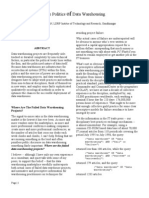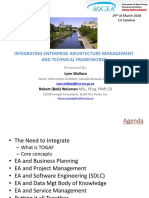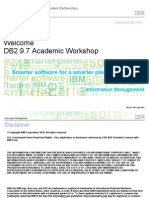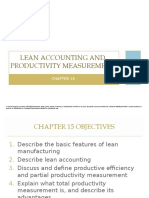Data Quality and Preprocessing Concepts ETL
Data Quality and Preprocessing Concepts ETL
Uploaded by
Rahul PanthriCopyright:
Available Formats
Data Quality and Preprocessing Concepts ETL
Data Quality and Preprocessing Concepts ETL
Uploaded by
Rahul PanthriOriginal Description:
Copyright
Available Formats
Share this document
Did you find this document useful?
Is this content inappropriate?
Copyright:
Available Formats
Data Quality and Preprocessing Concepts ETL
Data Quality and Preprocessing Concepts ETL
Uploaded by
Rahul PanthriCopyright:
Available Formats
The Need For Data Quality
Difficulty in decision making
Time delays in operation
Organizational mistrust
Data ownership conflicts
Customer attrition
Costs associated with
error detection
error rework
customer service
fixing customer problems
Poor Data Quality Impacts The Bottom Line
Six Steps To Data Quality
Understand
Information Flow
In Organization
Identify Potential
Problem Areas &
Asses Impact
Clean & Load
Data
Continuous
Monitoring
Identify Areas of
Improvement
1
2
3
4
5
6
Identify authoritative data sources
Interview Employees & Customers
Use business rule discovery tools to identify
data with inconsistent, missing, incomplete,
duplicate or incorrect values
Ratio of bad records to good records
Use data cleansing tools to clean data at the
source
Load only clean data into the data warehouse
Measure Quality
Of Data
Schedule Periodic Cleansing of Source Data
Identify & Correct Cause of Defects
Refine data capture mechanisms at source
Educate users on importance of DQ
Data Entry Points
Cost of bad data
Data Quality Analysis
Identify Inconsistencies
Codification differences
Multiple database entries of same entity
Out of range or missing values
Frequency Distribution
Uniqueness of keys
Referential Integrity
Compliance to other business rules
Examine Source Systems For Inconsistencies
Tools In The Market
Business Rule Discovery Tools
Integrity Data Reengineering Tool from Vality Technology
Trillium Software System from Harte-Hanks Data Technologies
Migration Architect from DB Star
WizRule, WizWhy, from WizSoft Inc
Data Reengineering & Cleansing Tools
Prism from Prism Solutions
Carlton Pureview from Oracle
ETI-Extract from Evolutionary Technologies
PowerMart from Informatica Corp
Sagent Data Mart from Sagent Technology
Tools In The Market
Name & Address Cleansing Tools
Centrus Suite from Sagent
I.d.centric from First Logic
Quality Defect Prevention Tools
Centrus Suite from Sagent
I.d.centric from First Logic
Data Quality Assessment Tools
Migration Architect, Evoke Axio from Evoke Software
Wizrule from Wizsoft
Why Data Preprocessing?
Data in the real world is dirty
incomplete: lacking attribute values, lacking
certain attributes of interest, or containing only
aggregate data
e.g., occupation=
noisy: containing errors or outliers
e.g., Salary=-10
inconsistent: containing discrepancies in codes or
names
e.g., Age=42 Birthday=03/07/1997
e.g., Was rating 1,2,3, now rating A, B, C
e.g., discrepancy between duplicate records
Forms of Data Preprocessing
Measuring the Dispersion of Data
Quartiles, outliers and boxplots
Quartiles: Q
1
(25
th
percentile), Q
3
(75
th
percentile)
Inter-quartile range: IQR = Q
3
Q
1
Boxplot: ends of the box are the quartiles, median is marked,
and plot outlier individually
Variance and standard deviation (sample: s, population: )
Variance: (algebraic, scalable computation)
Standard deviation s (or ) is the square root of variance s
2 (
or
2)
n
i
n
i
i i
n
i
i
x
n
x
n
x x
n
s
1 1
2
2
1
2 2
] ) (
1
[
1
1
) (
1
1
n
i
i
n
i
i
x
N
x
N
1
2
2
1
2 2
1
) (
1
How to Handle Missing Data?
Ignore the tuple: usually done when class label is missing.
Fill in the missing value manually: tedious + infeasible?
Fill in it automatically with
a global constant : e.g., unknown, a new class?!
the attribute mean
the attribute mean for all samples belonging to the same class:
smarter
the most probable value: use inference-based formula such as
Bayesian formula or decision tree
Noisy Data
Noise: random error or variance in a measured
variable
Incorrect attribute values may due to
faulty data collection instruments
data entry problems
data transmission problems
technology limitation
inconsistency in naming convention
Other data problems which requires data cleaning
duplicate records
incomplete data
inconsistent data
How to Handle Noisy Data?
Binning
first sort data and partition into (equal-frequency) bins
then one can smooth by bin means, smooth by bin median,
smooth by bin boundaries, etc.
Regression
smooth by fitting the data into regression functions
Clustering
detect and remove outliers
Combined computer and human inspection
detect suspicious values and check by human (e.g., deal with
possible outliers)
Binning Methods for Data Smoothing
Sorted data for price (in dollars): 4, 8, 9, 15, 21, 21, 24, 25, 26,
28, 29, 34
* Partition into equal-frequency (equi-depth) bins:
- Bin 1: 4, 8, 9, 15
- Bin 2: 21, 21, 24, 25
- Bin 3: 26, 28, 29, 34
* Smoothing by bin means:
- Bin 1: 9, 9, 9, 9
- Bin 2: 23, 23, 23, 23
- Bin 3: 29, 29, 29, 29
* Smoothing by bin boundaries:
- Bin 1: 4, 4, 4, 15
- Bin 2: 21, 21, 25, 25
- Bin 3: 26, 26, 26, 34
Regression
x
y
y = x + 1
X1
Y1
Y1
Cluster Analysis
Data Cleaning as a Process
Data discrepancy detection (not wanting to give details, outdated
address, poorly designed forms, too many options for questions)
Use any knowledge say metadata (e.g., domain, range, dependency,
distribution) your write your own scripts.
Check field overloading (2004/12/25, 25/12/2004.)
Check uniqueness rule, consecutive rule and null rule(zero, person
refusing to provide, blanks)
Data cleaning contd.
Use commercial tools
Data scrubbing: use simple domain knowledge (e.g., postal
code, spell-check) to detect errors and make corrections use
parsing, fuzzy matching techniques)
Data auditing: by analyzing data to discover rules and
relationship to detect violators (e.g., correlation and
clustering to find outliers)
ETL (Extraction/Transformation/Loading) tools: allow users to
specify transformations through a graphical user interface
Integration of the two processes
(www.control.cs.berkeley.edu.abc
Iterative and interactive (e.g., Potters Wheels)
Work in progress: writing declarative languages using
SQL for data cleaning
Data Integration
Data integration:
Combines data from multiple sources into a coherent store
Schema integration: e.g., A.cust-id B.cust-#
Integrate metadata from different sources
Entity identification problem:
Identify real world entities from multiple data sources, e.g., Bill
Clinton = William Clinton
Detecting and resolving data value conflicts
For the same real world entity, attribute values from different
sources are different
Possible reasons: different representations, different scales,
e.g., metric vs. British units
ETL
Ralph Speaks
Technical Design Challenges Posed
By The Data Warehouse Evolution
Timeliness
Data Volumes
Response Times
BI
Legacy
Systems
..
B2C
B2B
CRM
The Big Picture!
Which Approach Do We Take ?
Data Extraction and Preparation
Extract
Analyze, Clean
and Transform
Data Movement
and Load
Stage I
Stage II
Stage III
Periodic
Refresh/
Update
The ETL Process
Access data dictionaries defining source files
Build logical and physical data models for target
data
Survey existing systems to identify sources of
data
Specify business and technical rules for data
extraction, conversion and transformation
Perform data extraction and transformation
Load target databases
Metadata
Repository
Data
Definitions
Source
Databases
Data Modeling
Tool
RDBMS
MDDB
Define/code
Extraction Rules
Extract Program
Generation
Run Extract
Programs
Load Data
Warehouse
Source
Metadata Target
Metadata
Raw
Data
Clean
Data
The ETL Process
OLTP
Systems
Staging
Area
Data
Warehouse
Extract
OLTP
Systems
OLTP
Systems
Load
Transform
Stage I
Stage II
Stage III
The ETL Process
Data Extraction - Simplified
ETL Tools - Classification
First-generation
Code-generation products
Generate the source code
Second-generation
Engine-driven products
Generate directly executable code
ETL Tools - Classification
Due to more efficient architecture, second
generation tools have significant advantage over
first-generation
ETL Tools - First-Generation
Strengths
Tools are mature
Programmers are familiar
with code generation in
COBOL or C
Limitations
High cost of products
Complex training
Extract programs have to
compiled from source
Many transformations have
to coded manually
Lack of parallel execution
support
Most metadata to be
manually generated
Characterized by the Generation and Deployment of Multiple Codes
ETL Tools - Second-Generation
Extraction/Transformation/Load runs on server
Data directly extracted from source and processed on server
Data transformation in memory and written directly to warehouse
database. High throughput since intermediate files are not used
Directly executable code
Support for monitoring, scheduling, extraction, scrubbing,
transformation, load, index, aggregation, metadata
Characterized by the Transformation Engine
ETL Tools - Second-Generation
PowerCentre/Mart from Informatica
Data Mart Solution from Sagent Technology
DataStage from Ascential
ETL Tools - Selection
Support to retrieve, cleanse, transform,
summarize, aggregate, and load data
Engine-driven products for fast, parallel operation
Generate and manage central metadata repository
Open metadata exchange architecture
Provide end-users with access to metadata in
business terms
Support development of logical and physical data
models
Data Loading - First Time Loads
First load is a complex
exercise
Data extracted from
tapes, files, archives etc.
First time load might take
several days to complete
Extract, Clean,Transform etc
Source: www.survey.com
ETL Trends
DWH market is growing at 40-45% p.a.
Meta data management is shaping the market
Real time CRM requires real time DWH
E-comm and E-business are fuelling DWH & BI
ERP Data Warehousing is in demand
Major Trends
Source: Cutter Report - May 2000
ETL Trends
ETL technology built into other BI products
XML enabled platform independent data traffic
Near Real Time Data Warehouses using
middleware
Vendors have evolved their products into data
mart/analytical platforms
The Data Mart Strategy
The most common approach
Begins with a single mart and architected marts are added
over time for more subject areas
Relatively inexpensive and easy to implement
Can be used as a proof of concept for data warehousing
Can perpetuate the silos of information problem
Can postpone difficult decisions and activities
Requires an overall integration plan
Data Sources and Types
Primarily from legacy, operational systems
Almost exclusively numerical data at the present
time
External data may be included, often purchased
from third-party sources
Technology exists for storing unstructured data
and expect this to become more important over
time
Extraction, Transformation,
and Loading (ETL) Processes
The plumbing work of data warehousing
Data are moved from source to target data bases
A very costly, time consuming part of data
warehousing
Recent Development:
More Frequent Updates
Updates can be done in bulk and trickle modes
Business requirements, such as trading partner
access to a Web site, requires current data
For international firms, there is no good time to
load the warehouse
Recent Development:
Clickstream Data
Results from clicks at web sites
A dialog manager handles user interactions. An
ODS (operational data store in the data staging
area) helps to custom tailor the dialog
The clickstream data is filtered and parsed and
sent to a data warehouse where it is analyzed
Software is available to analyze the clickstream
data
Data Extraction
Often performed by COBOL routines
(not recommended because of high program
maintenance and no automatically generated meta
data)
Sometimes source data is copied to the target
database using the replication capabilities of
standard RDMS (not recommended because of
dirty data in the source systems)
Increasing performed by specialized ETL software
Sample ETL Tools
Teradata Warehouse Builder from Teradata
DataStage from Ascential Software
SAS System from SAS Institute
Power Mart/Power Center from Informatica
Sagent Solution from Sagent Software
Hummingbird Genio Suite from Hummingbird
Communications
Reasons for Dirty Data
Dummy Values
Absence of Data
Multipurpose Fields
Cryptic Data
Contradicting Data
Inappropriate Use of Address Lines
Violation of Business Rules
Reused Primary Keys,
Non-Unique Identifiers
Data Integration Problems
Data Cleansing
Source systems contain dirty data that must be
cleansed
ETL software contains rudimentary data cleansing
capabilities
Specialized data cleansing software is often used.
Important for performing name and address
correction and householding functions
Leading data cleansing vendors include Vality
(Integrity), Harte-Hanks (Trillium), and Firstlogic
(i.d.Centric)
Steps in Data Cleansing
Parsing
Correcting
Standardizing
Matching
Consolidating
Parsing
Parsing locates and identifies individual data
elements in the source files and then isolates
these data elements in the target files.
Examples include parsing the first, middle, and
last name; street number and street name; and
city and state.
Correcting
Corrects parsed individual data components using
sophisticated data algorithms and secondary data
sources.
Example include replacing a vanity address and
adding a zip code.
Standardizing
Standardizing applies conversion routines to
transform data into its preferred (and consistent)
format using both standard and custom business
rules.
Examples include adding a pre name, replacing a
nickname, and using a preferred street name.
Matching
Searching and matching records within and
across the parsed, corrected and standardized
data based on predefined business rules to
eliminate duplications.
Examples include identifying similar names and
addresses.
Consolidating
Analyzing and identifying relationships between
matched records and consolidating/merging them
into ONE representation.
Data Staging
Often used as an interim step between data extraction and
later steps
Accumulates data from asynchronous sources using
native interfaces, flat files, FTP sessions, or other
processes
At a predefined cutoff time, data in the staging file is
transformed and loaded to the warehouse
There is usually no end user access to the staging file
An operational data store may be used for data staging
Data Transformation
Transforms the data in accordance with the
business rules and standards that have been
established
Example include: format changes, deduplication,
splitting up fields, replacement of codes, derived
values, and aggregates
Data Loading
Data are physically moved to the data warehouse
The loading takes place within a load window
The trend is to near real time updates of the data
warehouse as the warehouse is increasingly used
for operational applications
Meta Data
Data about data
Needed by both information technology personnel
and users
IT personnel need to know data sources and
targets; database, table and column names;
refresh schedules; data usage measures; etc.
Users need to know entity/attribute definitions;
reports/query tools available; report distribution
information; help desk contact information, etc.
Recent Development:
Meta Data Integration
A growing realization that meta data is critical to
data warehousing success
Progress is being made on getting vendors to
agree on standards and to incorporate the sharing
of meta data among their tools
Vendors like Microsoft, Computer Associates, and
Oracle have entered the meta data marketplace
with significant product offerings
Thats lots of ETL.
Come back to basics: let us revise
You might also like
- Data Platform & Analytics Foundational For Data Platform Competency (MPN14354)Document15 pagesData Platform & Analytics Foundational For Data Platform Competency (MPN14354)nguyen le100% (1)
- THE STEP BY STEP GUIDE FOR SUCCESSFUL IMPLEMENTATION OF DATA LAKE-LAKEHOUSE-DATA WAREHOUSE: "THE STEP BY STEP GUIDE FOR SUCCESSFUL IMPLEMENTATION OF DATA LAKE-LAKEHOUSE-DATA WAREHOUSE"From EverandTHE STEP BY STEP GUIDE FOR SUCCESSFUL IMPLEMENTATION OF DATA LAKE-LAKEHOUSE-DATA WAREHOUSE: "THE STEP BY STEP GUIDE FOR SUCCESSFUL IMPLEMENTATION OF DATA LAKE-LAKEHOUSE-DATA WAREHOUSE"Rating: 2 out of 5 stars2/5 (2)
- Data Strategy TemplateDocument18 pagesData Strategy TemplateGuillermo Solis67% (3)
- Data Quality RemediationDocument9 pagesData Quality RemediationXavier Martinez Ruiz50% (2)
- Sas Data Governance Framework 107325Document12 pagesSas Data Governance Framework 107325Daniel Softjoy MontjoyNo ratings yet
- Data Quality ServicesDocument196 pagesData Quality ServicesrajbmohanNo ratings yet
- Informatica Data Quality PDFDocument44 pagesInformatica Data Quality PDFAjay SinghNo ratings yet
- Wazir K Mcqs CmputerDocument250 pagesWazir K Mcqs Cmputernoor100% (1)
- HeroSelect Readme PDFDocument9 pagesHeroSelect Readme PDFcaracallaxNo ratings yet
- Creating A Retaining Wall Using Civil 3D Feature Lines and Grading ObjectsDocument6 pagesCreating A Retaining Wall Using Civil 3D Feature Lines and Grading ObjectsMateo AndresNo ratings yet
- Army Universal Assault Rifle Steyr Semi Automatic Aug Cal 5-56-223 MM Nato ManualDocument44 pagesArmy Universal Assault Rifle Steyr Semi Automatic Aug Cal 5-56-223 MM Nato Manualchevy-usa-1No ratings yet
- DELL XPS 13-9350 AAZ80 LA-C881P r1.0 A00Document59 pagesDELL XPS 13-9350 AAZ80 LA-C881P r1.0 A00nomi_nomi100% (1)
- Introduction to Data Platforms: How to leverage data fabric concepts to engineer your organization's data for today's cloud-based digital worldFrom EverandIntroduction to Data Platforms: How to leverage data fabric concepts to engineer your organization's data for today's cloud-based digital worldNo ratings yet
- Data Quality FrameworkDocument28 pagesData Quality FrameworkSoham Paria100% (1)
- Data Quality PolicyDocument4 pagesData Quality PolicyKavya GopakumarNo ratings yet
- What Is A Chief Data OfficerDocument9 pagesWhat Is A Chief Data Officerrajgopalv2No ratings yet
- Dataversity - Data Quality - 20210826Document32 pagesDataversity - Data Quality - 20210826Eric Lodeve100% (2)
- Enterprise Data Governance A Complete Guide - 2019 EditionFrom EverandEnterprise Data Governance A Complete Guide - 2019 EditionNo ratings yet
- Ds Data Quality Business IntelligenceDocument2 pagesDs Data Quality Business IntelligenceRakesh Reddy GeetlaNo ratings yet
- Taking Data Quality To The Enterprise Through Data GovernanceDocument28 pagesTaking Data Quality To The Enterprise Through Data Governancekvnumashankar100% (1)
- Analytics Strategy Presentation PDFDocument82 pagesAnalytics Strategy Presentation PDFJoker JrNo ratings yet
- Master Data Management PresentationDocument9 pagesMaster Data Management PresentationlinehandNo ratings yet
- Data Quality A Survey of Data Quality DimensionsDocument5 pagesData Quality A Survey of Data Quality DimensionsPayam Hassany Sharyat PanahyNo ratings yet
- Data Profiling With Informatica Data QualityDocument5 pagesData Profiling With Informatica Data QualityusermaniNo ratings yet
- Data Profiling PPT - How ToDocument69 pagesData Profiling PPT - How Tosandeep batlad100% (2)
- Data Stewardship Template GuideDocument5 pagesData Stewardship Template Guide2810idawe100% (1)
- Enterprise Data Office PoVDocument10 pagesEnterprise Data Office PoVmallekrishna123No ratings yet
- Govindarajan Data Vault PDFDocument29 pagesGovindarajan Data Vault PDFnewelljj100% (1)
- How To Scale Data GovernanceDocument13 pagesHow To Scale Data GovernanceI DumaireNo ratings yet
- 5 Fundamental Data Quality PracticesDocument12 pages5 Fundamental Data Quality PracticesshirazhaseebNo ratings yet
- Collibra Data Governance CenterDocument14 pagesCollibra Data Governance CenterHost MomNo ratings yet
- Data Quality Assessment GuideDocument7 pagesData Quality Assessment GuideNewCovenantChurchNo ratings yet
- Global ServicesDocument15 pagesGlobal Servicesparth_upadhyay_1No ratings yet
- Data Governance Good Practices PDFDocument8 pagesData Governance Good Practices PDFTYNo ratings yet
- Data GovernanceDocument25 pagesData GovernanceRichard MmassyNo ratings yet
- AtScale Technical OverviewDocument18 pagesAtScale Technical OverviewKeiLa Ganán RugelNo ratings yet
- The 5 Ways Modern Data Governance Helps Business ProductivityDocument12 pagesThe 5 Ways Modern Data Governance Helps Business ProductivityCarolinaJiménez100% (1)
- Talk - Data Quality FrameworkDocument30 pagesTalk - Data Quality FrameworkMatthew Lawler100% (1)
- Data Quality Assessment Manager (DQAM)Document2 pagesData Quality Assessment Manager (DQAM)AnalytiXDSNo ratings yet
- Proactive Data GovernanceDocument9 pagesProactive Data GovernanceAlbert SuryadiNo ratings yet
- Data Governance BookDocument11 pagesData Governance BookAbhishek PrasadNo ratings yet
- 7 - Informatica Data CleanseDocument43 pages7 - Informatica Data CleansejbeatoflNo ratings yet
- Informatica GDPR Overview Steve HolyerDocument43 pagesInformatica GDPR Overview Steve HolyerbiohzardNo ratings yet
- Informatica MDM (Overview)Document8 pagesInformatica MDM (Overview)prashaanth55No ratings yet
- Data Quality Management Best PracticesDocument9 pagesData Quality Management Best Practicesselinasimpson2201No ratings yet
- Data Governance A Conceptual Framework in Order To Prevent Your Data Lake From Becoming A Data SwampDocument45 pagesData Governance A Conceptual Framework in Order To Prevent Your Data Lake From Becoming A Data SwampJhon ChafloqueNo ratings yet
- Tableau DATA GovernanceDocument7 pagesTableau DATA Governanceemceemouli100% (2)
- Enterprise Data Strategy1Document6 pagesEnterprise Data Strategy1sabashsabashNo ratings yet
- Finservices Data GovernanceDocument1 pageFinservices Data GovernancexxcarxxNo ratings yet
- Data Governance Plan WorksheetDocument2 pagesData Governance Plan WorksheetPaulo Iván Gómez Trujillo100% (1)
- The Politics of Data WarehousingDocument9 pagesThe Politics of Data WarehousingVaibhav C GandhiNo ratings yet
- Dmbok and CDMPDocument40 pagesDmbok and CDMPcheska ongpin100% (1)
- Designing A Logical Data ModelDocument42 pagesDesigning A Logical Data ModelJan Ryan ReluniaNo ratings yet
- Top Data Integration Trends and BestDocument18 pagesTop Data Integration Trends and BestjohnccminNo ratings yet
- Getting Started With MDMDocument22 pagesGetting Started With MDMdesijnk100% (2)
- Data Catalog StrategyDocument30 pagesData Catalog Strategysolaluaji100% (1)
- 12 Requirements For A Modern Data Architecture in A Hybrid Cloud WorldDocument23 pages12 Requirements For A Modern Data Architecture in A Hybrid Cloud WorldTarun Tyagi100% (1)
- OBIEE Semantic LayerDocument3 pagesOBIEE Semantic LayerDylan WanNo ratings yet
- Jmieti: Jai Parkash Mukand Lal Innovative Engineering & Technology Institute, (JMIETI) RadaurDocument6 pagesJmieti: Jai Parkash Mukand Lal Innovative Engineering & Technology Institute, (JMIETI) RadaurAshok KumarNo ratings yet
- Voluson S10 - Interactive Brochure (En)Document47 pagesVoluson S10 - Interactive Brochure (En)Zákány ZoltánNo ratings yet
- SyllabusDocument11 pagesSyllabus伯阿No ratings yet
- Advan Robot Lec1 Ch1Document47 pagesAdvan Robot Lec1 Ch1Thafer MajeedNo ratings yet
- Eurotech U Boot PDFDocument38 pagesEurotech U Boot PDFBritoJuniorNo ratings yet
- Resource Management and Analysis Best Practices For DtapowerDocument22 pagesResource Management and Analysis Best Practices For DtapowerJagadeeh ValasapalliNo ratings yet
- SCORDocument25 pagesSCORmicuentascribd1100% (1)
- Illustra PRO Gen4 Outdoor PTZ Data Sheet V4Document5 pagesIllustra PRO Gen4 Outdoor PTZ Data Sheet V4unstrainNo ratings yet
- 1.0 - WelcomeDocument13 pages1.0 - Welcomeracroi3010No ratings yet
- Difference in COGI and CO1P - SAP BlogsDocument7 pagesDifference in COGI and CO1P - SAP BlogsVigneshNo ratings yet
- Harmonic Load Flow Calculation Divergence or Mismatch IssueDocument2 pagesHarmonic Load Flow Calculation Divergence or Mismatch IssueFabian Andres Calderon HernandezNo ratings yet
- Ricoh Aficio MP7000 Trouble Error Codes PDFDocument35 pagesRicoh Aficio MP7000 Trouble Error Codes PDFNafeesAhmadNo ratings yet
- Frequently Asked Questions: SWIFT Test Sparring PartnerDocument7 pagesFrequently Asked Questions: SWIFT Test Sparring PartnerkawaiivanikunNo ratings yet
- Arduino LCD KeyPad ShieldDocument6 pagesArduino LCD KeyPad ShieldIrving Zuñiga RiveraNo ratings yet
- Alia Bhat Ad ImcDocument3 pagesAlia Bhat Ad ImcJai DeepNo ratings yet
- Decomposition MethodsDocument12 pagesDecomposition Methodssubham mishraNo ratings yet
- DLV WP2 - 12 - Feasibility Study - PublishedDocument39 pagesDLV WP2 - 12 - Feasibility Study - Publishedprincess johnNo ratings yet
- Lean AccountingDocument42 pagesLean AccountingAmamore Lorenzana PlazaNo ratings yet
- LALRPDocument8 pagesLALRPਰਜਨੀ ਖਜੂਰਿਆNo ratings yet
- NCVTCTSCertificateAnnual R200821006133Document1 pageNCVTCTSCertificateAnnual R200821006133Sibaprasad DashNo ratings yet
- 1.3.3.5 Packet Tracer - Packet Switching SimulationDocument1 page1.3.3.5 Packet Tracer - Packet Switching SimulationWelly AndriNo ratings yet
- Csec Mathematics Syllabus Exam 2018Document22 pagesCsec Mathematics Syllabus Exam 2018Anderson AlfredNo ratings yet
- Training Module For Lab Technicians Blood Cell CounterDocument18 pagesTraining Module For Lab Technicians Blood Cell CounterMichael SalvadorNo ratings yet
- Sky65170-11: 860 - 900 MHZ, 0.5 W High Power Power AmplifierDocument10 pagesSky65170-11: 860 - 900 MHZ, 0.5 W High Power Power AmplifiercopslockNo ratings yet
- Ee/Econ 458 Introduction To Linear Programming: J. MccalleyDocument25 pagesEe/Econ 458 Introduction To Linear Programming: J. Mccalleykaren dejoNo ratings yet

























































































